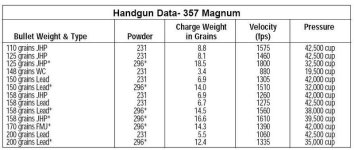I'd like to get some advice on fine tuning a load for 38 special using HP-38 powder with Hornady dry lubricated 158gr LSWC.
I recently finished a lot of 50 - in two batches. Everything came out very well, except that there was a LOT of smoke when either batch was fired. This was done at an inside range, with admittedly poor circulation. I shot several factory rounds, which were dirtier (more residue on the 686), but little or no smoke. Is it possible that my light loads were responsible for the smoke?
The first 25, I loaded with 3.2 gr of HP-38; the second group of 25, I used 3.4 gr. I did see a slight difference in recoil between these two groups, but both were considerably lighter than the factory rounds. The recoil was somewhere between a 22 and a factory light 38.
What could I do to not get the excess smoke? I feel that I need to make an increase in the amount of powder for a more robust round. What would be a good measure to go to without causing excessive leading?
I got my loads from two different sources - 3.1 min and 3.7 max load for this bullet and powder - for regular 38 special rounds. +P for Winchester 231 lists starting load of 4.5gr.
Thx -
RR
I recently finished a lot of 50 - in two batches. Everything came out very well, except that there was a LOT of smoke when either batch was fired. This was done at an inside range, with admittedly poor circulation. I shot several factory rounds, which were dirtier (more residue on the 686), but little or no smoke. Is it possible that my light loads were responsible for the smoke?
The first 25, I loaded with 3.2 gr of HP-38; the second group of 25, I used 3.4 gr. I did see a slight difference in recoil between these two groups, but both were considerably lighter than the factory rounds. The recoil was somewhere between a 22 and a factory light 38.
What could I do to not get the excess smoke? I feel that I need to make an increase in the amount of powder for a more robust round. What would be a good measure to go to without causing excessive leading?
I got my loads from two different sources - 3.1 min and 3.7 max load for this bullet and powder - for regular 38 special rounds. +P for Winchester 231 lists starting load of 4.5gr.
Thx -
RR



